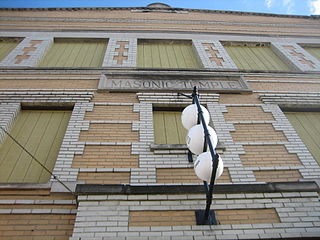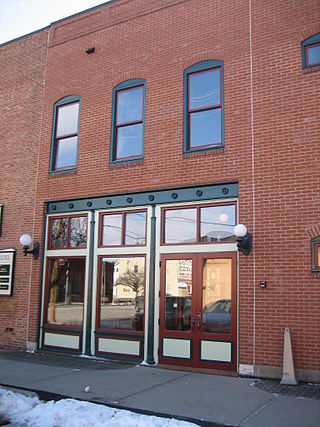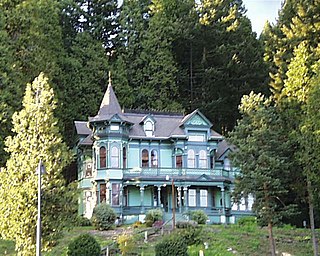
The Main Street Historic District encompasses the historic commercial center of Middletown, Connecticut, United States. Middletown was one of the most important ports on the Connecticut River during the colonial period, and Main Street "has been the center of community life since the earliest period of settlement". Today Main Street is home to a number of 19th century buildings, maintaining the bulk of its historic character. It was listed on the National Register of Historic Places in 1983.

The Oregon Commercial Historic District is a historic district in Oregon, Illinois, that has been listed on the National Register of Historic Places since 2006. The district is roughly bordered by Jefferson, Franklin, 5th and 3rd Streets in Oregon. It is one of six Oregon sites listed on the National Register and one of three to be so listed since the turn of the 21st century. The other two are the Oregon Public Library, listed in 2003, and the Chana School, listed in 2005.

The Ogle County Courthouse is a National Register of Historic Places listing in the Ogle County, Illinois, county seat of Oregon. The building stands on a public square in the city's downtown commercial district. The current structure was completed in 1891 and was preceded by two other buildings, one of which was destroyed by a group of outlaws. Following the destruction of the courthouse, the county was without a judicial building for a period during the 1840s. The Ogle County Courthouse was designed by Chicago architect George O. Garnsey in the Romanesque Revival style of architecture. The ridged roof is dominated by its wooden cupola which stands out at a distance.

Iron Mike is an 1896 cast-iron fountain in the 400 Block of Washington Street in the city of Oregon, Illinois. It is located at the site of the Ogle County Courthouse, at the intersection of Illinois Route 2 and Route 64. Iron Mike is four feet tall and three feet wide, at its widest point. The fountain's lowest tier is a pool for pets and reads "Illinois Humane Society." There is a step for children on the south side of the fountain and on the north, street, side, the largest middle tier was made to be accessible to horses. On the rear side of the horse basin is a "bubbler" for adults, it is also reachable by children via the iron step. The multi-tier fountain was originally set into a concrete base which was immediately adjacent to the curb of Route 64. In 2021 Iron Mike was relocated 15 feet away from the road unto the property of the Ogle County Courthouse.

The Masonic Temple Lodge No. 420 is a building in the Ogle County, Illinois city of Oregon. It has historically been known as 628-628 S. Fourth St. The building is one of several in the 100 Block of Oregon's South Fourth Street that is a contributing property to the Oregon Commercial Historic District, some others include the buildings at 125 S. Fourth St. and 127 S. Fourth St. As part of the historic district the Temple Lodge is listed on the National Register of Historic Places as of August 2006.

The Schiller Piano Company was an American manufacturer of pianos in Oregon, Illinois. It operated independently from 1890 to 1936, when it merged with the Cable Company and thereafter produced pianos under the name Cable and Conover. Thousands of pianos were produced in its factory, which was operated by corporate successors until 1971. The 120,000-square-foot (11,000 m2), stucco-clad building was renovated for use as an indoor mall in 1975 and today operates as the Conover Square Mall.

125 S. Fourth St. is the address of an unnamed historic building in the Ogle County, Illinois city of Oregon. The building is part of the Oregon Commercial Historic District and as such is part of the National Register of Historic Places. The district and its contributing properties were added to the Register in August 2006. The building has been altered somewhat from its original appearance including wood siding added to the first floor level and the addition of signage. It stands near the rest of the 100 Block of South Fourth Street, which includes other historic buildings at 127 S. Fourth St., 121-123 S. Fourth St., to which 125 is adjacent and the Masonic Temple Lodge No. 420.

The Jacobs Block, also known as the National Clothing House, is an 1870s historic building encompassing addresses in the 400 Block of Washington Street and the 100 Block of North Fourth Street in Oregon, Illinois. The Jacobs Block is part of Ogle County's only nationally designated historic district. The area, known as the Oregon Commercial Historic District, was added to the National Register of Historic Places in August 2006. The building, listed as a contributing structure to the historic district, is the Oregon Historic District's largest.

The building at 302 Washington St. in Oregon, Illinois is part of trio of historic Italianate commercial buildings within the boundaries of the Oregon Commercial Historic District from 300-306 Washington. The structure acts mostly as a hallway area between the buildings at 300 Washington St. and the F.G. Jones Block. The interior and exterior have been significantly restored on all three buildings. As part of the Commercial Historic District 300 Washington Street was added to the National Register of Historic Places in August 2006.

The commercial buildings in the Sycamore Historic District, located in Sycamore, Illinois, United States, are mostly located in and around the city's downtown. The largest concentration of commercial contributing properties to the historic district are found along Illinois Route 64 as it passes through Sycamore. They include several buildings known as "blocks" which can consist of more than one adjacent and attached structure, as is the case with the Waterman Block, one of the Sycamore commercial buildings.

The Central Troy Historic District is an irregularly shaped, 96-acre (39 ha) area of downtown Troy, New York, United States. It has been described as "one of the most perfectly preserved 19th-century downtowns in the [country]" with nearly 700 properties in a variety of architectural styles from the early 19th to mid-20th centuries. These include most of Russell Sage College, one of two privately owned urban parks in New York, and two National Historic Landmarks. Visitors ranging from the Duke de la Rochefoucauld to Philip Johnson have praised aspects of it. Martin Scorsese used parts of downtown Troy as a stand-in for 19th-century Manhattan in The Age of Innocence.

Walter David Pugh was an American architect based in Salem, Oregon, United States.

Valparaiso has retained an active downtown. It remains a mix of government, retail and business center, with a mixed residential and service area. Numerous economic changes have not changed the basic character, historic courthouse area. The historic district retains the distinctive turn-of-the-19th-century architecture, supporting numerous small specialty shops, shaded sidewalks, and a people friendly environment. The Downtown District, is anchored on the Porter County Courthouse. It includes 14-blocks surrounding the square, bounded on the north by Jefferson Street, on the east by Morgan Street, on the south by Monroe Street, and on the west by Napoleon Street.
Tourtellotte & Hummel was an American architectural firm from Boise, Idaho and Portland, Oregon.

The Downtown Athens Historic District is a historic area in the Downtown Athens neighborhood of Athens, Georgia. It was listed on the National Register of Historic Places in 1978. Its boundaries were revised twice, in 1984 and 2006, and additional documentation was filed in 2006.
Benton & Benton was an architectural partnership in eastern North Carolina of brothers Charles C. Benton Sr. and Frank W. Benton. Several of its works are listed on the U.S. National Register of Historic Places. Charles C. Benton Jr. and others also worked for the firm.

The Mesker Brothers Iron Works and George L. Mesker & Co. were competing manufacturers and designers of ornamental sheet-metal facades and cast iron storefront components from the 1880s through the mid-twentieth century. The Mesker Brothers Iron Works was based in St. Louis, Missouri, and was operated by brothers Bernard and Frank Mesker. The George L. Mesker Company was operated by a third brother, George L. Mesker, and was based in Evansville, Indiana. The Mesker brothers were the sons of John Mesker who operated a stove business in Evansville and later galvanized iron for buildings. The three brothers learned their iron-working skills from their father.

The Port Washington Downtown Historic District is the largely intact remainder of the old commercial downtown of Port Washington, Wisconsin, United States. It consists of about 40 contributing buildings built from the 1850s to the 1950s in various styles. The district was added to the National Register of Historic Places in 2000 for significance to both architecture and the history of commerce.

Columbus Historic District is a national historic district located at Columbus, Bartholomew County, Indiana, United States. It encompasses 574 contributing buildings and 1 contributing sites in the central business district and surrounding residential areas of Columbus. It was developed between about 1850 and 1930, and includes notable examples of Federal and Italianate style architecture. A number of commercial buildings feature locally manufactured cast iron and pressed metal components. Located in the district are the separately listed Bartholomew County Courthouse, Columbus City Hall, and First Christian Church. Other notable buildings include the First National Bank, The Crump Theatre (1889), Reo Theater, Ulrich Bakery, Samuel Harris House (1853), Keller House (1860), Old Post Office (1910), Franklin Building, Gent Mill, First United Presbyterian Church (1871-1885), Irwin Block, Irwin Home and Gardens, and St. Batholomew's Roman Catholic Church (1891).
















